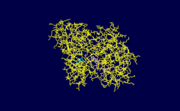Sandbox 160
From Proteopedia
| Line 5: | Line 5: | ||
== Structure & Function == | == Structure & Function == | ||
| + | Glyceraldehyde 3-Phosphate Dehydrogenase (GAPDH)has carefully been studied in a number of bacterial, parasitic and mammalian species and it has been found that it exists as homotetrameric protein <ref name="reference 1"/>. | ||
The enzyme contains a functional NAD+ group which functions as a hydrogen acceptor during the course of the reaction which is bound to a Rossman fold. During the catalysis of glyceraldehyde 3-phosphate to 1,3-biphosphoglycerate a hydride ion is enzymatically transferred from the aldehyde group of glyceraldehyde 3-phosphate to the nicotinamide ring of NAD+ reducing it to NADH (pink)<ref name="reference 1">19243605 </ref>. The active site of GAPDH contains a cysteine (Cys149 colored green) residue which reacts with the glyceraldehyde 3-phosphate molecule through its -SH group. The substrate is covalently bound during the reaction through its aldehyde group to the -SH group of the cysteine residue and the resulting reaction produces a thiohemiacetal intermediate <ref name="reference 1"/>. Note that this reaction occurs through acid base catalysis with aid of a histidine residue (His176).The <scene name='Sandbox_160/Newscene/1'>active site</scene> of the molecule is illustrated to the right. | The enzyme contains a functional NAD+ group which functions as a hydrogen acceptor during the course of the reaction which is bound to a Rossman fold. During the catalysis of glyceraldehyde 3-phosphate to 1,3-biphosphoglycerate a hydride ion is enzymatically transferred from the aldehyde group of glyceraldehyde 3-phosphate to the nicotinamide ring of NAD+ reducing it to NADH (pink)<ref name="reference 1">19243605 </ref>. The active site of GAPDH contains a cysteine (Cys149 colored green) residue which reacts with the glyceraldehyde 3-phosphate molecule through its -SH group. The substrate is covalently bound during the reaction through its aldehyde group to the -SH group of the cysteine residue and the resulting reaction produces a thiohemiacetal intermediate <ref name="reference 1"/>. Note that this reaction occurs through acid base catalysis with aid of a histidine residue (His176).The <scene name='Sandbox_160/Newscene/1'>active site</scene> of the molecule is illustrated to the right. | ||
Revision as of 23:39, 31 March 2010
Contents |
Introduction
| |||||||||
| 1vc2, resolution 2.60Å () | |||||||||
|---|---|---|---|---|---|---|---|---|---|
| Ligands: | |||||||||
| Activity: | Glyceraldehyde-3-phosphate dehydrogenase (phosphorylating), with EC number 1.2.1.12 | ||||||||
| |||||||||
| |||||||||
| Resources: | FirstGlance, OCA, RCSB, PDBsum, TOPSAN | ||||||||
| Coordinates: | save as pdb, mmCIF, xml | ||||||||
Glyceraldehyde 3-Phosphate dehydrogenase (GAPDH) is an Oxidoreductase enzyme and is involved in many important biochemical reactions. This protein is responsible for catalyzing the conversion of glyceraldeyde 3-Phosphate into 1,3-Biphosphoglycerate in a two step coupled mechanism. This conversion occurs during step 6 or the beginning of the "payoff phase" of glycolysis (the second half of the entire process) in which ATP and NADH is produced. A total of 2 NADH and 4 ATP are produced during this phase for a net gain of 2 NADH and 2 ATP for the entire glycolysis pathway per glucose.
Structure & Function
Glyceraldehyde 3-Phosphate Dehydrogenase (GAPDH)has carefully been studied in a number of bacterial, parasitic and mammalian species and it has been found that it exists as homotetrameric protein [1].
The enzyme contains a functional NAD+ group which functions as a hydrogen acceptor during the course of the reaction which is bound to a Rossman fold. During the catalysis of glyceraldehyde 3-phosphate to 1,3-biphosphoglycerate a hydride ion is enzymatically transferred from the aldehyde group of glyceraldehyde 3-phosphate to the nicotinamide ring of NAD+ reducing it to NADH (pink)[1]. The active site of GAPDH contains a cysteine (Cys149 colored green) residue which reacts with the glyceraldehyde 3-phosphate molecule through its -SH group. The substrate is covalently bound during the reaction through its aldehyde group to the -SH group of the cysteine residue and the resulting reaction produces a thiohemiacetal intermediate [1]. Note that this reaction occurs through acid base catalysis with aid of a histidine residue (His176).The of the molecule is illustrated to the right.
A simplified illustration of the net reaction is as follows:
D-glyceraldehyde 3-phosphate + phosphate + NAD+ ---------> 1,3 biphospho-D-glycerate + NADH + H+
The Pi that is involved in the reaction functions to attack by phosphorolysis the thioester intermediate that is formed by the substrate on the cysteine reside after NAD+ has been reduced [1]. The attack by Pi on the carbonyl carbon of C1 is simultaneously followed by the replacement of bound NADH for NAD+ so another turn of the cycle can now commence. The final product is released as 1,3 bisphosphoglycerate in which the second Pi molecule has been incorporated.
Active Site in Detail


